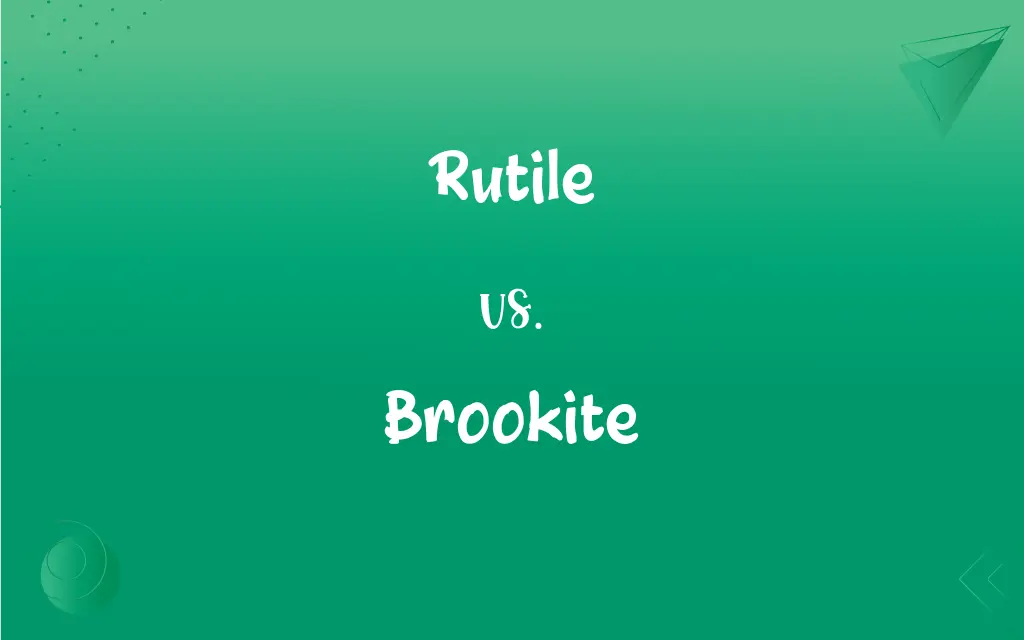Rutile vs. Brookite: What's the Difference?
Edited by Aimie Carlson || By Harlon Moss || Published on February 14, 2024
Rutile is a titanium dioxide mineral with a tetragonal crystal structure, often used in pigments and gems; brookite is also a titanium dioxide mineral but with an orthorhombic crystal structure.

Key Differences
Rutile is a naturally occurring mineral form of titanium dioxide (TiO2) with a tetragonal crystal system. Brookite, also a form of TiO2, differs in that it crystallizes in the orthorhombic system, giving it a distinct crystal shape compared to rutile.
Rutile often exhibits a reddish-brown color and is well-known for its high refractive index and dispersion, making it valuable in gemology. Brookite, on the other hand, typically appears in brownish or yellowish hues and is less commonly used in jewelry due to its more brittle nature.
Rutile is widely distributed in metamorphic and igneous rocks and is a common inclusion in various gemstones, enhancing their aesthetic appeal. Brookite is relatively rarer and is often found in alpine fissures and as a weathering product of titaniferous magnetite.
Due to its stability and high refractive index, rutile is extensively used in paints, plastics, paper, and as a gemstone. Brookite, while not as commercially significant as rutile, is studied for its unique crystallography and potential in photocatalytic applications.
In gemology, rutile's needle-like inclusions in stones like quartz are prized for their beauty. Brookite, though less common in gemology, is recognized among collectors and mineralogists for its unique and varied crystal habits.
ADVERTISEMENT
Comparison Chart
Crystal Structure
Tetragonal
Orthorhombic
Typical Color
Reddish-brown
Brownish, yellowish
Refractive Index
High
Lower than rutile
Common Occurrence
Metamorphic and igneous rocks
Alpine fissures, weathering of titaniferous magnetite
Primary Uses
Pigments, gemstones, industrial applications
Crystallography studies, photocatalysis
ADVERTISEMENT
Rutile and Brookite Definitions
Rutile
Rutile occurs in a variety of igneous and metamorphic rocks.
They found large rutile deposits in these metamorphic rocks.
Brookite
Brookite is an orthorhombic mineral form of titanium dioxide.
This brookite specimen is notable for its unique crystal structure.
Rutile
Rutile is known for its high refractive index and dispersion.
The brilliance of this gem is enhanced by the rutile inclusions.
Brookite
Brookite is less common than other titanium dioxide forms.
Finding brookite is rare compared to rutile or anatase.
Rutile
Rutile is used in producing refractory ceramic and as a pigment.
Titanium white paint contains rutile as a primary component.
Brookite
Brookite is studied for its photovoltaic and photocatalytic properties.
Researchers are examining brookite for its use in solar energy applications.
Rutile
Rutile is a reddish-brown titanium dioxide mineral.
The rutile crystals in this rock sample give it a unique shimmer.
Brookite
Brookite forms in alpine fissures and metamorphosed limestone.
In these mountains, you can find brookite in the alpine fissures.
Rutile
Rutile commonly appears as needle-like inclusions in gemstones.
Star sapphires owe their asterism to rutile needles.
Brookite
Brookite often appears in brownish or yellowish colors.
The brookite crystals here have a distinctive yellowish hue.
Brookite
A mineral form of titanium dioxide, TiO2, having characteristic orthorhombic crystals and a red-brown to black color.
Brookite
(mineral) A dark brown mineral form of titanium dioxide, with the chemical formula TiO2.
Brookite
A mineral consisting of titanic oxide, and hence identical with rutile and octahedrite in composition, but crystallizing in the orthorhombic system.
FAQs
How are rutile and brookite different in crystal structure?
Rutile is tetragonal, while brookite is orthorhombic.
What colors are typical for rutile?
Reddish-brown is common for rutile.
What colors does brookite usually have?
Brookite is often brownish or yellowish.
How is brookite used?
Mainly in crystallography studies and potential photocatalytic uses.
What is brookite?
An orthorhombic form of titanium dioxide.
Are brookite crystals used in gemology?
Rarely, as they are less common and not typically used in jewelry.
What is unique about brookite crystals?
Their unique crystal structure and rarity.
Can rutile be synthesized?
Yes, synthetic rutile is produced for various applications.
What is rutile?
A titanium dioxide mineral with a tetragonal crystal structure.
What are the primary uses of rutile?
In pigments, gemstones, and industrial applications.
Is rutile used in jewelry?
Yes, especially for its inclusions in gemstones.
Is rutile visible to the naked eye in rocks?
Yes, especially as inclusions in gemstones.
What are the typical occurrences of brookite?
In alpine fissures and as a weathering product.
Is brookite synthesized?
It's less commonly synthesized than rutile.
What is the refractive index of rutile?
It has a high refractive index.
How does brookite's refractive index compare to rutile's?
It's lower than rutile’s.
Are there health concerns associated with rutile?
Generally safe, but precautions are necessary in industrial processing.
Where is rutile commonly found?
In metamorphic and igneous rocks.
How is brookite identified?
Through its crystal structure and color.
What makes rutile unique in gemology?
Its needle-like inclusions create special effects in gemstones.
About Author
Written by
Harlon MossHarlon is a seasoned quality moderator and accomplished content writer for Difference Wiki. An alumnus of the prestigious University of California, he earned his degree in Computer Science. Leveraging his academic background, Harlon brings a meticulous and informed perspective to his work, ensuring content accuracy and excellence.
Edited by
Aimie CarlsonAimie Carlson, holding a master's degree in English literature, is a fervent English language enthusiast. She lends her writing talents to Difference Wiki, a prominent website that specializes in comparisons, offering readers insightful analyses that both captivate and inform.































































